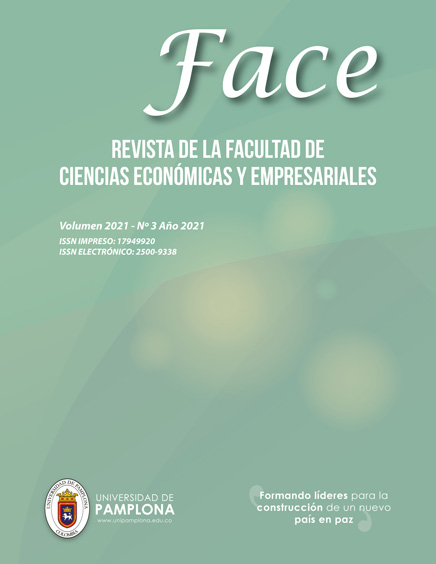Presence of the double jeopardy phenomenon in the purchase of recurrent consumer products in mexican households
DOI:
https://doi.org/10.24054/face.v21i3.1135Resumen
La Para identificar la presencia del fenómeno de la doble incriminación en los hogares mexicanos, se realizó un estudio
cuantitativo longitudinal a través de un panel de 65 hogares en el Estado de Morelos, 65 hogares en la Ciudad de
México y 22 hogares en Yucatán, los tickets de Compra realizados fueron registraron en Excel durante 12 semanas, y
luego analizaron y midieron los comportamientos de compra recurrentes en esos hogares. Los productos
seleccionados fueron cereales y yogur.
Como resultado, se encontró la presencia de doble Jeopardy en las compras realizadas por los hogares mexicanos.
La investigación también reporta pequeñas desviaciones y excepciones, todos los consumidores son diferentes y
generalmente tienden a comportarse de manera homogénea con el segmento al que pertenecen.
Descargas
Referencias
AMAI(7 of 12 of 2015).Mexican Associationof MarketResearchand Public OpinionAgencies.Obtained from AMAI: http://nse.amai.org/nseamai2/
Arnould, EJ, Price, LL andZinkhan, GM (2004)Consumers,McGraw Hill
Barnard, NE (1990)Robustmesures ofconsumerbrandbelifs.Journal of MarketingResearch27 (11) pp 477-484
Bunge, M. (1983).Scientific research.His strategy and his philosophy.Barcelona: Ariel.
Cabrera, D. (2010).Advantages and disadvantages of using adeductive / inductive methodin business administration research.Management &Society, July, 173-187.
Chaudhuri, A. (1995)"BrandEquityorDoubleJeopardy?"JournalofProductand Brand Management,4 (1) pp.26-32
Dawes, J., Bond, A.,Hartnett, N. and Sharp, B. (2017).Is Double Jeopardy applied using average spending per buyer as a loyalty metric?AustralasianMarketingJournal(AM), 25 (4), 261-268.
Ehrenberg, A.(1972).RepeatBuying:TheoryandApplications.Amsterdan:North-HollandPublishing Company.
Ehrenberg, A.,Goodhardt, G. (1977).Understandingbuyerbehavior.New York:Walter Thompson Co.
Ehrenberg, A. (1987)Thelinkingandviewingof regular TV series.Journal of Marketing Research28 (8) pp 9-14
Ehrenberg, A. (1988).Repeatbuying:facts,theoryandapplications.2nd ed.,London, New York: Oxford Univ.Press.
Ehrenberg, AG (1990).Double Jeopardy Revised.Journal of Marketing, 54, 82-91.Ehrenberg, A. (1997).BE or not BE.Proceedings of the Advertising Research Federation, 7-9.
Ehrenberg, A.,&Goodhard,G.(2002) Double Jeopardy Revisited, Again.Journal of marketing insights.LOVE.Pp.40-42
Ehrenberg, A. (2004).My Research in Marketing: How it Happened.Marketing Research.VOl.1 6, Issue 4, 36-42.
Greenacre, L., Tanusondjaja, A., Dunn, S. and Page, B. (2015).Use of experiments of choice to find double jeopardypatterns.International Market Research Magazine,57(5), 743-758.
Hernández, RF (2014).Research methodology.Mexico: McGraw-Hill.
Hoek, J., Kearns, Z. and Wilkenson, K. (2003) “A New Brand's Behavior in an Established Market,” Journal of Product and Brand Management, 12 (1) pp.52-65
León, OM (1997).Research DesignMadrid: McGraw Hill.
Lynn, M. (2008).Frequency strategies and double jeopardy in marketing: The pitfall of relying on loyalty program.Cornell Hospitality Report, 8 (12), 6-12.
Martin, C. (1973).The Theory of Double Jeopardy.Journal of the AcademyofMarketingScience,1,, 148-155.
Michael, JS (1999).The Theory of Double Jeopardy: An Example from a Forest Products Industry.Forest Products Journal, 49 (3) March, 21-26.
Nagy, M., Bennett, D. and Graham, C. (2019).Why include BOP in your international marketing strategy.International marketing magazine.
Rodríguez, AP (2017).Scientific methods of inquiry and knowledge construction.School of Business Administration Magazine,no.82, 1-26.
Sedgwick, P. (2014).Cross sectional studies: advantages and disadvantages.Medical research journalMarch, 1-2.
Shaw, J. (2004).Marketing Popular Music with Branding : Double Jeopardy in the South African Music MarketSchool of Economic andBusiness Sciences, at the University of the Witwatersrand, Johannesburg, 1-64.
Singh, JE (2008).Measuring customer loyalty to product variants.International Journal of MarketResearch Vol. 50 Issue 4, 513-532.
Tarkiainen, A. and Ellonen, HK (2015).Does the offline market share generate online loyalty?Double jeopardyphenomenonin the context of print magazines and magazine websites.International Magazine of Marketing and Internet Advertising,9(3), 254-266.
Wilkie, DC and Johnson, LW (2017).The existence of double jeopardywithin the order of entry of the effect.Strategic Marketing Magazine,25(4), 334-341.
Wilson, D. and Winchester, M. (2019).Extend the double jeopardyand duplication of the purchase laws to the wine market.International Journal of Wine Business Research.
Yang, ZB (2005).The Double Jeopardy Phenomenon and the Mediating Effect of Brand Penetration between Advertising and Brand Loyalty.Journal of Advertising Research, 45 (2), 211-221.
Zhilin, YB (2005).The Double Jeopardy Phenomenon and the Mediating Effect of Brand Penetration between Advertising and Brand Loyalty.Journal of Advertising ResearchJune, 211-220.
Zikmund, W. (2003).Fundamentals of market research.Madrid: Thomson Publishing
Descargas
Publicado
Versiones
- 2021-09-10 (5)
- 2024-03-07 (4)
- 2023-07-19 (3)
- 2023-03-22 (2)
- 2022-01-31 (1)
Número
Sección
Licencia
Derechos de autor 2021 FACE: Revista de la Facultad de Ciencias Económicas y Empresariales

Esta obra está bajo una licencia internacional Creative Commons Atribución-NoComercial-CompartirIgual 4.0.





